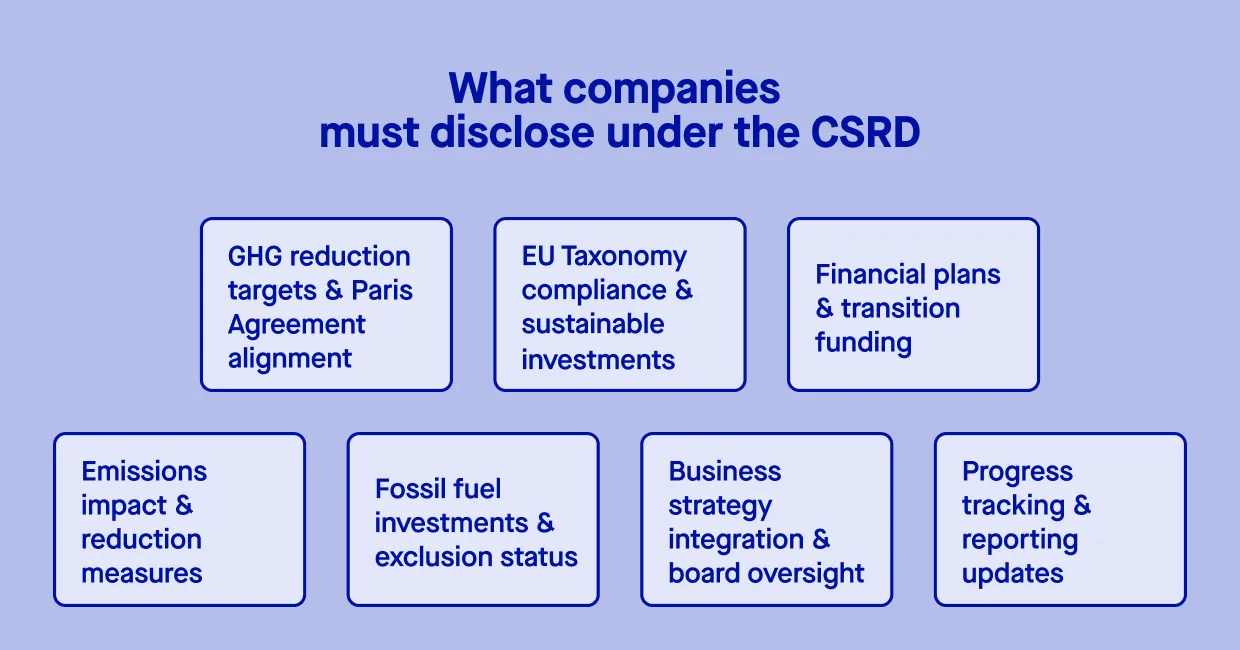The urgent impacts of climate change demand immediate action. Governments, investors, and consumers now expect businesses to respond with robust strategies that integrate sustainability into their operations. In this evolving landscape, the European Union (EU) Corporate Sustainability Reporting Directive (CSRD) is a game-changer for corporate sustainability reporting, requiring over 50,000 companies to disclose their climate-related risks and mitigation strategies.
Beyond regulatory compliance, the CSRD offers companies an opportunity to drive meaningful change. By embedding sustainability into their core business models, companies can enhance resilience, strengthen stakeholder trust, and align with long-term value creation.
However, many businesses still struggle with data quality, technical complexities, and defining credible climate transition plans.
What is a climate transition plan?
A climate transition plan (CTP) is a strategic roadmap outlining how an organization intends to reduce greenhouse gas (GHG) emissions and align its business model with climate goals. Under the CSRD, companies report on their transition strategies, demonstrating how they plan to achieve net-zero emissions while ensuring long-term financial sustainability.
These plans go beyond setting ambitious targets—they require concrete actions and measurable milestones. A credible plan should outline key decarbonization levers, financial resources allocated for implementation, and governance structures to ensure accountability. Stakeholders, including investors, employees, and regulators, expect clear, actionable plans that reflect the company’s commitment to climate action at a global level.
What does the CSRD require when it comes to climate transition plans?
The CSRD mandates that EU companies provide transparent and standardized sustainability reporting, including detailed climate transition plans. These plans must align with the Paris Agreement’s 1.5°C target and integrate key regulatory frameworks such as the EU Taxonomy.
Under CSRD reporting guidance, companies must disclose the following sustainability matters:
- GHG reduction targets aligned with the Paris Agreement.
- Plans to align business activities with EU Taxonomy climate criteria.
- Financial investments supporting the transition.
- Potential locked-in emissions from assets and products impacting GHG targets.
- Measures to reduce emissions across products, services, and technologies.
- Significant investments in coal, oil, or gas-related activities.
- Exclusion status from EU Paris-aligned Benchmarks.
- Integration of the transition plan with overall business strategy and financial planning.
- Board approval and oversight of the transition plan.
- Updates on implementation progress.
By making climate transition plans a key aspect of corporate sustainability reporting, the CSRD ensures that businesses take a structured and transparent approach to emissions reduction and climate risk management.

How should you start putting together a CSRD-compliant transition plan?
Developing a CSRD-compliant transition plan is a complex but necessary process for EU companies. Here are key steps to ensure alignment with the directive:
Assess current climate risks and impacts
Begin by conducting a thorough assessment of your organization’s climate risks, carbon footprint, and existing sustainability initiatives. This evaluation will help identify key areas for emissions reduction and operational adjustments.
Define science-based targets
Ensure that your climate targets align with the Paris Agreement and the Science-Based Targets initiative (SBTi). Setting clear, science-based goals strengthens credibility and compliance with ESG reporting requirements.
Align strategy with EU Taxonomy regulations
The CSRD requires companies to demonstrate how their transition plans align with the EU Taxonomy, a classification system for sustainable economic activities. Ensure that your sustainability strategy meets the criteria set out under EU law.
Develop an implementation roadmap
Outline the steps your company will take to decarbonize operations, transition to low-carbon technologies, and integrate sustainability into financial planning. Specify timelines, key performance indicators (KPIs), and accountability structures.
Secure board approval and governance oversight
Board-level commitment is crucial for ensuring the success of a transition plan. Companies must provide evidence of board approval and ongoing governance mechanisms to monitor progress.
Communicate transparently with stakeholders
A well-structured transition plan should be accessible and transparent to employees, consumers, investors, and regulators. Clearly outline how your organization is addressing climate change while balancing business objectives.
How can ESG software support this process?
Navigating the complexities of CSRD compliance requires a data-driven approach, and ESG software solutions play a crucial role in streamlining sustainability reporting. Here’s how ESG software can support the transition process:
- Centralizing sustainability data
One of the biggest challenges companies face is managing and consolidating vast amounts of climate-related data. ESG software helps organizations collect, validate, and structure data in a standardized format, ensuring compliance with CSRD rules.
- Automating reporting processes
Manually compiling corporate sustainability reports is time-consuming and prone to errors. ESG software automates reporting workflows, reducing administrative burdens and ensuring accuracy in disclosures.
- Tracking emissions and target progress
Advanced ESG platforms provide real-time tracking of emissions, energy consumption, and sustainability KPIs. This enables companies to monitor progress against their transition plans and make data-driven adjustments.
- Enhancing transparency and auditability
With increasing regulatory scrutiny, ensuring data integrity is critical. ESG software solutions facilitate audit-ready documentation, improving transparency and credibility in climate-related reporting.
- Scenario analysis and risk assessment
Many ESG platforms offer built-in risk modeling and scenario analysis tools, helping companies assess climate-related financial risks and adjust their strategies accordingly.
- Aligning with global reporting frameworks
ESG software helps organizations align their disclosures with various global sustainability reporting standards, including the Task Force on Climate-related Financial Disclosures (TCFD) and the Global Reporting Initiative (GRI), ensuring compliance beyond national law.
European sustainability reporting standards and other requirements
As part of the push for greater corporate transparency, companies subject to the CSRD are required to adhere to European sustainability reporting standards (ESRS) approved by the European Commission. This includes aligning with frameworks like the Sustainable Finance Disclosure Regulation (SFDR) and the Non-Financial Reporting Directive (NFRD).
The CSRD also emphasizes the importance of double materiality, which requires companies to evaluate and disclose information on how sustainability issues affect their financial performance and how their operations impact the environment. By ensuring comprehensive sustainability information and disclosure requirements are met, companies contribute to a more sustainable global economy.
These efforts also enhance companies’ ability to attract sustainable investments, as they provide clearer and more reliable sustainability data for investors and other stakeholders. This shift to greater transparency aligns with the growing demand for non-financial reporting, particularly for large companies and non-EU companies that are now required to meet these standards in their European operations.
As the Council of the European Union continues to enforce these regulations, countries within Europe are also stepping up their efforts to ensure local businesses comply with these requirements. In this context, businesses must consider the scope of their operations and how they report climate-related risks and opportunities across borders, especially for non-EU companies operating within Europe.
Moving forward with climate transition planning
Climate transition plans are a fundamental requirement under the CSRD, ensuring that companies report transparently on their decarbonization efforts. While regulatory compliance is the primary driver, a well-structured climate strategy presents an opportunity for businesses to integrate sustainability into their core strategies, driving long-term value creation.
To navigate this complex landscape, organizations must develop credible strategies that align with regulatory expectations, integrate sustainability into financial planning, and leverage ESG software to streamline reporting. As EU member states enforce the corporate sustainability reporting directive requirements, companies that proactively address climate risks will be better positioned to thrive in a rapidly evolving global economy.
By embracing structured and transparent planning, businesses can contribute to climate change mitigation while reinforcing their competitiveness and resilience in a sustainable future.




